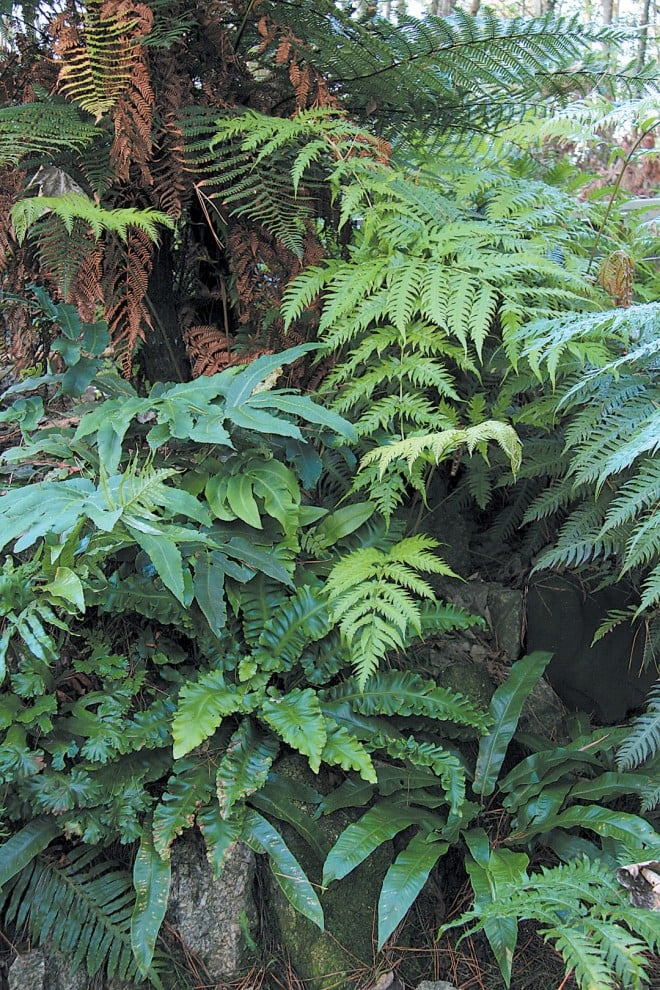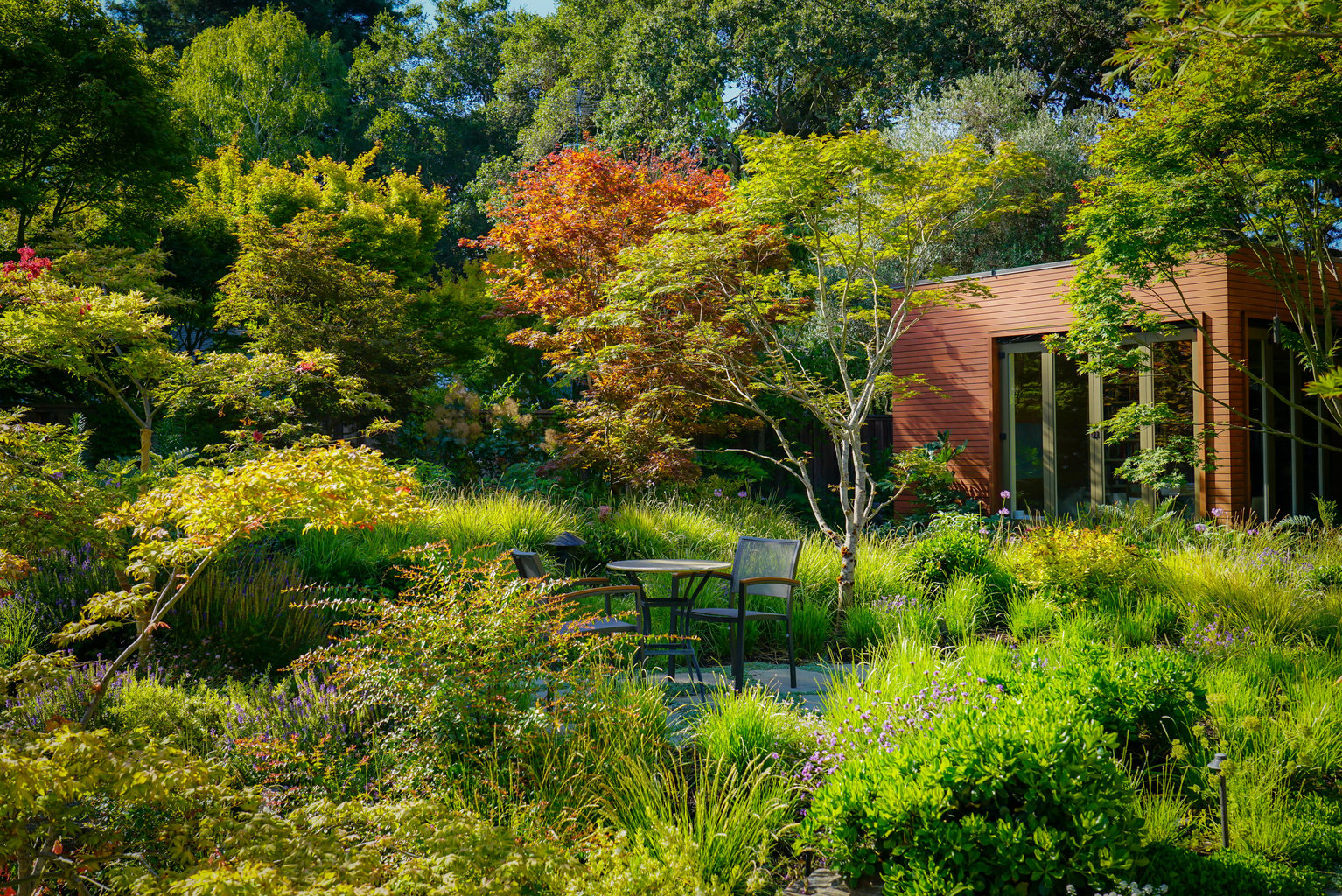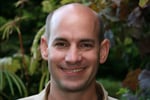

Contributor
- Topics: Archive

When one thinks of ferns, a picture of lush abundance comes to mind of cool shady woodland settings and delicate fronds covered in dew. In these days of strong emphasis on foliage and texture in the garden, it is hard to imagine that, not so long ago, plants as useful as ferns were hard to come by in any variety, even in the Pacific Northwest where ferns could easily be a regional symbol (just below the Douglas-fir). Except for offerings from small specialty mail-order nurseries, little more than a handful of native ferns were available. Occasionally, one could find dried up hunks of root sealed in a plastic bag hanging from a store shelf proclaiming to contain a fern of great beauty; unfortunately, many of these bags held little more than imminent compost.
A group of experienced and passionate gardeners wanted more. So, from among a small but dedicated group of Seattle area fern enthusiasts, the Hardy Fern Foundation (HFF) was formed in 1989. In the past twenty years, membership has grown from a supportive Northwest group to an international membership encompassing fern fanciers from Britain, Germany, Latvia, Belgium, Canada, Austria, and Italy, as well as from across the United States.
Presenting Ferns
The Hardy Fern Foundation’s goals then, as now, were “to establish a comprehensive collection of the world’s hardy ferns for display, testing, evaluation, public education, and introduction to the gardening and horticultural community.” With these goals in mind, the organization set out to find a site to host the first test and display garden. The ideal site was in Federal Way, Washington, at the Rhododendron Species Botanical Garden, a woodland garden covering twenty-two acres, with, at the time, a young collection of rhododendrons and related woody plants. The Hardy Fern Foundation’s goals then, as now, were “to establish a comprehensive collection of the world’s hardy ferns for display, testing, evaluation, public education, and introduction to the gardening and horticultural community.” Ferns struck many of us as the ideal companions for these grand shrubs. Since the initial plantings in 1990, over 2,400 plants, representing about 200 species, have been added to the garden.
To further test species for hardiness and ornamental value, temperate ferns have been propagated and planted in HFF display and satellite gardens in varying climate zones throughout North America. Every year, new species and selections are supplied to seventeen adjunct gardens, ranging from the Coastal Maine Botanical Garden in Boothbay and Alabama’s Birmingham Botanical Gardens in the East, to Inniswood Metro Gardens in Columbus, Ohio, the Rotary Gardens in Janesville, Wisconsin, and Whitehall Historic Home and Garden in Louisville, Kentucky in the Midwest. Other gardens can be found in Dallas, Colorado, California, Alaska, and, of course, the greater Seattle area. The newest planting features over 700 donated ferns representing about a hundred different species and selections in a new display area at the Bellevue Botanical Garden in Bellevue, Washington.
The HFF has also been a pioneer in demonstrating innovative ways to display ferns. How to create and maintain a fern table has been featured in workshops in the past several years. Fern tables, large and small, are now focal points in a number of area gardens. In addition, construction of a large stumpery, probably the largest in the US, is now under way at the Rhododendron Species Botanical Garden. It’s inverted tree trunks will offer a unique way to view and enjoy ferns—an idea that can be duplicated on a small scale in private gardens.

Discussing Ferns
Reports detailing the successes and failures of ferns in these gardens are published in the organization’s Quarterly to guide growers and would-be growers throughout the temperate world toward ferns that are appropriate in hardiness and ornamental value for their respective areas. The HFF’s Quarterly is the only publication in the world solely dedicated to dissemination of information on hardy ferns, providing information on fern cultivation, profiles of different species, book reviews, and indepth reports on places to see ferns. Occasional issues of the Quarterly are devoted to specific topics. Past publications (available by special order) include a Propagation Handbook, a Directory of Fern Gardens, Nurseries, and Reserves in the United States and Canada, and a Hardy Garden Fern Evaluation, with descriptions of select fern gardens and appropriate plantings in various areas of the United States.
To celebrate the foundation’s first twenty years, more special editions are planned, including an update of the Directory, an index of ferns and articles covering all twenty years of the Quarterly, and an issue dedicated to our associated display and satellite gardens. A comprehensive “How To” handbook will be published this spring, with articles for beginners and experts on wintering tree ferns; creating special effects (eg, a stumpery, a bog, a fern table, a cobble, a tufa wall); getting started in the woodland; and growing from spores, as well as general cultural guidelines and, for the advanced enthusiast, observations on phylogeny.

Dispersing Ferns
Many of the ferns distributed by the foundation to its display sites are also available to its members. Some of these selections are quite rare and difficult to find by other means. North American natives like the dwarf version of the Western maidenhair (Adiantum aleuticum ‘Subpumilum’) and the handsome coastal leathery polypody (Polypodium scouleri) are now scattered among members’ gardens. Extraordinary exotics, lusted after by many but owned by few, have also been propagated and made available. One of the most fantastic is Woodwardia unigemmata. This large evergreen fern makes a bold statement in the garden with its four to six-foot-long fronds, but the real show comes from the new fronds: blood red sprouts emerge in late spring, opening to intensely colored fronds, slowly fading to a rich, dark green. On well-grown plants in late summer appear small bulbils on the ends of the fronds, each ready to root and grow into a new plant.
Other exciting offerings may bear names few have heard of, like the apple green Gymnocarpium oyamense. Named after the Oya region in Japan, this delicate deciduous fern slowly forms a low carpet about six inches tall; a docile spreader, it can be used without fear of a garden coup. Lingering in the shadows for years, Polystichum ×dycei has now become widely available. A laboratory-made hybrid of the handsome, bulbil-producing Polystichum proliferum and the hardy and tough Polystichum braunii, this delightful fern combines the best traits of both parents in a vigorous, garden-worthy plant.

Touring Ferns
Travel is especially popular with foundation members; over the years, many articles have been written covering special ferning sites in North America as well as the United Kingdom, New Zealand, Germany, Chile, and the island of Réunion. Many of these places have also been ferny destinations in a travel program jointly sponsored by the British Pteridological Society and the HFF. Past trips focused on our Pacific Northwest, the Mid-Atlantic states, Germany, and Texas. Future forays are planned for California, the southeastern US, and New England. Not only have these brought enthusiasts to great gardens and field sites, they have also introduced an international cadre of experts and newcomers to each other—a great pleasure for all.
An added bonus of these travels is the potential for introducing new species to cultivation. The HFF has actively propagated spores from such far-flung places as China, Vietnam, Chile, Turkey, and New Zealand. New ferns are accurately identified and evaluated for garden worthiness. Some of these spores are available through our spore exchange, along with spores collected from cultivated plants of gardening enthusiasts in Europe, the UK, and North America.
The HFF website (www.hardyferns.org), is encyclopedic in the depth of information presented, and is continually updated. Look for sections providing answers to the most frequently asked questions, and listings of resources, including places to buy and see ferns, and recommended reading. Look for the event calendar as well as a new and ever-expanding gallery of fern photographs. Yes, a picture is worth a thousand words, as not all ferns look alike!
The Fern Festival is the annual highlight event and features a comprehensive (perhaps the largest assembled in the US) assortment of native and exotic ferns, as well as a large selection of recommended companion plants, for sale. Every year, on the first Friday and Saturday of June, Seattle’s Center for Urban Horticulture fills with these offerings. The sale is staffed by experts and serves both the fern newcomer and the collector who can spot a newly introduced fern from across the room. An evening lecture rounds out the festivities and spotlights fern specialists and enthusiasts from around the world. Past speakers have included the late Reg Kaye, Dr Chris Page, and Martin Rickard from the UK; John Mickel, Robbin Moran, the late Herb Wagner, Carl Taylor, and Barbara Hoshizaki from the US; and Seattle members Dr Arthur Kruckeberg, Richie Steffen, Sylvia Duryee, and John van den Meerendonk.
Be part of our celebration and join us in celebrating ferns. The future is foliage and foliage is ferns!
The Hardy Fern Foundation
On June 6, 2009, the annual Fern Festival features Sue Olsen, founder of the Hardy Fern Foundation and owner of Foliage Gardens in Bellevue, Washington—the oldest mail order nursery for spore-grown ferns in the US. Sue is a leading expert on ferns and is the author of one of the best books on the subject, the recently published Encyclopedia of Garden Ferns (Timber Press, 2007). For more information about the Hardy Fern Foundation and the Fern Festival, visit www.hardyferns.org.
Share:
Social Media
Garden Futurist Podcast
Most Popular
Videos
Topics
Related Posts

Low Maintenance Gardens – Better for Pollinators and People
Autumn 2022 “I come out every day. It’s therapy, my meditation.” Janet’s young garden transformed from overgrown, invasive plants to mostly natives. The dailiness of

Invasive Plants Are Still Being Sold: Preventing Noxious Weeds in Your Landscape
Autumn 2022 With so many beautiful ornamental plant species and cultivars throughout California and the Pacific Northwest, how do you decide which ones to include

Garden Design in Steppe with Transforming Landscapes with Garden Futurist Emmanuel Didier
Summer 2022 Listen to full Garden Futurist: Episode XVII podcast here. Emmanuel Didier, Principal and Creative Director at Didier Design Studio is a leading figure

Seslerias: Versatile Groundcover Meadow Grasses
Summer 2022 Without question, the most beautiful and versatile of all the groundcover meadow grasses are the moor grasses (Sesleria). Moor grasses tick off all









Responses